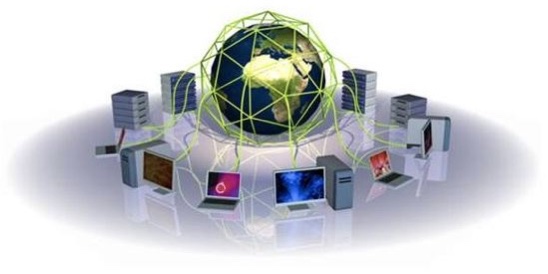
WHAT IS A GRID?
A
Grid is a way of connecting computers together to allow the sharing of
both computer processing power and data storage. A user may submit a
job, and software (called middleware) will check the user's credentials
and find a suitable computer on which to run the job. This computer may
be anywhere in the world, provided it is part of the grid infrastructure
to which the user has submitted the job. More explanation of what a
Grid is is available from the CERN Computing pages.
The Large Hadron Collider (LHC)
at CERN near Geneva is the largest scientific instrument on the
planet. Before it switched on, the LHC was expected to produce roughly 15 Petabytes (15
million Gigabytes) of data annually, but by 2016 the LHC was exceeding both its design luminosity and duty cycle, generating over 30PB of data a year. Data that thousands of scientists around
the world need to access and analyse. Grid Computing was chosen as the
solution for the analysis of LHC data by the Particle Physics community.
The Particle Physics Department was instrumental in this decision from
the beginning and has continued to play a major role in the management,
development, deployment and maintenance of Grid technology.
Within the UK most of the work is carried out as part of the UK Computing for Particle Physics GridPP project and the European Grid Infrastructure EGI project.
GRID DEPLOYMENT:
The Worldwide LHC Computing Grid WLCG
project is building and maintaining a data storage and analysis
infrastructure for the entire high-energy physics community that will
use the LHC.
The data from the LHC experiments are distributed around the globe, according to a four-tiered model. A
primary backup is recorded on tape at CERN, the "Tier-0" centre of
WLCG. After initial processing, this data is distributed to a
series of Tier-1 centres, large computer centres with sufficient storage
capacity and with round-the-clock support for the Grid. The Tier-1
centres make data available to Tier-2 centres, each consisting of
one or several collaborating computing facilities, which can store
sufficient data and provide adequate computing power for specific
analysis tasks. Individual scientists access these facilities
through Tier-3 computing resources, which can consist of local clusters
in a University Department or even individual PCs, and which may be
allocated to LCG on a regular basis.
GridPP has built a
distributed computing Grid across the UK primarily for the use of
particle physicists, this forms the UK part of the WLCG. In the United
Kingdom, there are 4 Tier 2 facilities, NorthGrid, SouthGrid, ScotGrid
and London Grid. The Particle Physics Department hosts SouthGrid
facilities: which are distributed between the Universities of Bristol,
Birmingham, Cambridge, Oxford and Sussex and the Rutherford Appleton Laboratory.
The department is also one of 17 Tier 3 facilities within the United
Kingdom. Staff in the Particle Physics department also contribute to the
deployment and support for the UK Tier 1 centre at RAL. The combined Tier 2/3 in the department currently provides just over 4,000 CPU cores and 3,000 TB of data storage to local and remote researchers, principally supporting the Atlas, CMS and LHCb experiments but also supporting more than 20 smaller communities (Virtual Organisations in the grid terminology).
GRID SECURITY:
In
any computing system, security is an important concern. In the Grid
environment, security poses some additional problems. In EGI the
Security Co-ordination Group SCG is responsible for the overall security coordination.
The EGI Grid Security Vulnerability Group SVG and The EGEE/WLCG Joint Security Policy Group SPG are co-funded by EGEE and GridPP and are led by members of the Particle Physics Department.
MANAGEMENT, DOCUMENTATION and USER SUPPORT:
Members of the Particle Physics department are part of the management board of the GridPP project, and support the CERN experiments use of the RAL tier 1 as co-ordinators for ATLAS, CMS and LHb.
